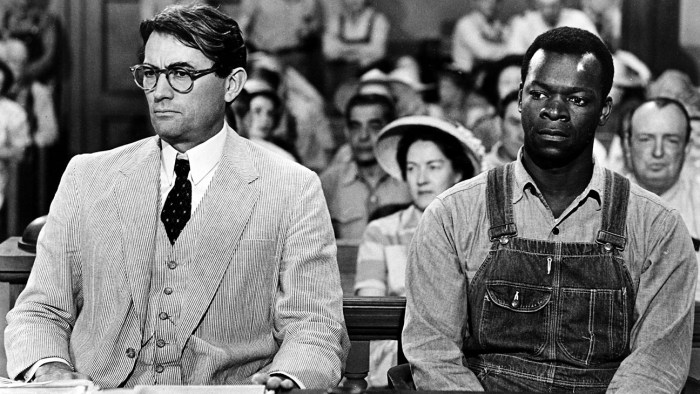To Kill a Mockingbird Poem, a timeless classic, embarks us on an extraordinary journey that delves into the complexities of human nature, prejudice, and the pursuit of justice. Harper Lee’s masterpiece paints a vivid portrait of the American South during the Jim Crow era, where racial tensions and social injustices cast a long shadow over the lives of its inhabitants.
At the heart of this compelling narrative lies a cast of unforgettable characters, each carrying their own unique burdens and aspirations. Atticus Finch, the embodiment of integrity and compassion, guides us through this tumultuous landscape, while Scout Finch, his precocious and inquisitive daughter, serves as our窗口 into a world both familiar and deeply unsettling.
Character Analysis

The novel’s characters play crucial roles in conveying its themes and driving the plot. Let’s delve into the personalities, motivations, and relationships of the central characters.
Atticus Finch
Atticus Finch embodies integrity, compassion, and unwavering principles. His wisdom and empathy guide him in navigating the prejudices and injustices of Maycomb society. As a lawyer, he defends Tom Robinson, a black man falsely accused of rape, despite the community’s opposition.
Scout Finch
Scout, Atticus’s tomboyish daughter, possesses a keen sense of observation and a strong moral compass. She challenges societal norms and confronts prejudice head-on. Through her innocent perspective, the reader gains insights into the complexities of the adult world.
Boo Radley
Boo Radley, a mysterious and enigmatic figure, lives as a recluse in the neighborhood. Initially feared by the children, Boo’s true nature is gradually revealed as a kind and gentle soul. His interactions with Scout and Jem challenge preconceived notions and highlight the importance of empathy.
Symbolism and Motifs

Harper Lee’s To Kill a Mockingbirdis a novel rich in symbolism and motifs. These literary devices contribute to the novel’s themes and enhance the reader’s understanding of the characters and their experiences.
The Mockingbird
The mockingbird, a recurring symbol throughout the novel, represents innocence, purity, and the beauty of nature. Killing a mockingbird is considered a sin because it harms a creature that brings joy and wonder to the world. The novel’s protagonist, Atticus Finch, emphasizes this point when he tells his children, “It’s a sin to kill a mockingbird.”
The mockingbird also symbolizes the vulnerability of the innocent. Tom Robinson, a black man falsely accused of rape, is an example of a “mockingbird” who is unjustly harmed by society.
The Treehouse
The treehouse is a place of refuge and imagination for Scout and Jem Finch. It is a place where they can escape the prejudices and complexities of the adult world. The treehouse also represents the children’s growing independence and their ability to see the world from a different perspective.
The Radley Place
The Radley Place is a mysterious and forbidden place that represents the unknown and the fear of the other. The children are fascinated by the Radleys, but they are also afraid of them. The Radley Place symbolizes the prejudice and intolerance that exists in the community of Maycomb.
Themes and Messages: To Kill A Mockingbird Poem

At its core, To Kill a Mockingbirdexplores profound themes that resonate deeply with the human experience. These themes, woven intricately into the novel’s fabric, serve as a mirror to our own society, reflecting the complexities and contradictions of the human condition.
Racism and Prejudice
Racism and prejudice cast a dark shadow over the novel’s setting of Maycomb, Alabama, in the 1930s. Through the eyes of Scout Finch, we witness the insidious nature of these evils as they manifest in the town’s treatment of African Americans, particularly Tom Robinson.
The novel exposes the hypocrisy and injustice of a society that claims to uphold equality yet perpetuates systemic racism.
The Importance of Justice, To kill a mockingbird poem
The pursuit of justice is a central theme that drives the narrative. Atticus Finch, Scout’s father and a respected lawyer, embodies the principles of integrity, fairness, and the rule of law. Through his unwavering belief in Tom Robinson’s innocence, Atticus demonstrates the crucial role of individuals in upholding justice, even in the face of overwhelming prejudice.
The Need for Understanding and Compassion
To Kill a Mockingbirdemphasizes the transformative power of understanding and compassion. Scout’s journey of growth and maturity is marked by her ability to see the world from different perspectives, particularly those of marginalized groups. The novel challenges readers to question their own biases and to embrace empathy as a means of fostering a more just and equitable society.
Literary Techniques
Harper Lee’s To Kill a Mockingbird is renowned for its literary techniques that enhance its impact and effectiveness. These techniques, including point of view, narrative structure, and language, contribute to the novel’s realism, emotional depth, and thought-provoking nature.
In Harper Lee’s classic “To Kill a Mockingbird,” the themes of justice and compassion resonate deeply. These same principles are reflected in the business practices of Toms Shoes, a company that has made a positive impact through its One for One model.
Like Atticus Finch’s unwavering defense of Tom Robinson, Toms Shoes believes in giving back to the community. By integrating their SWOT analysis here , we can gain insights into how their strengths and opportunities align with the values espoused in “To Kill a Mockingbird.”
First-Person Narration
The novel is narrated from the first-person perspective of Scout Finch, a young girl. This technique allows readers to experience the events through Scout’s eyes, shaping their understanding of the characters and themes. Scout’s innocence and curiosity provide a unique lens through which the complex world of Maycomb is explored.
Use of Flashbacks
Lee employs flashbacks to reveal crucial events from the past that inform the present. These flashbacks provide insights into characters’ motivations and the evolution of relationships. The flashback structure allows the reader to piece together the complex narrative and understand the interconnectedness of events.
Figurative Language
Lee masterfully employs figurative language to create vivid imagery and convey emotions. Similes, metaphors, and personification are used throughout the novel to enhance the narrative and connect with readers on a deeper level. For example, Boo Radley is described as a “malevolent phantom,” capturing his enigmatic and misunderstood nature.
Symbolism
The novel is rich in symbolism, where objects and characters represent abstract ideas. The mockingbird, for instance, symbolizes innocence and the importance of protecting the vulnerable. The treehouse where Scout and Jem play represents their childhood and the sanctuary of their imagination.
Cultural Impact

Harper Lee’s “To Kill a Mockingbird” has left an indelible mark on American culture, shaping attitudes towards race, justice, and empathy. The novel’s exploration of these themes has sparked discussions, inspired movements, and continues to resonate with readers today.
Impact on Racial Attitudes
Published in 1960, during the height of the Civil Rights Movement, “To Kill a Mockingbird” offered a powerful indictment of racial prejudice and its devastating consequences. The novel’s protagonist, Atticus Finch, became an iconic symbol of integrity and moral courage, inspiring generations of Americans to fight for racial equality.
The novel’s depiction of the trial of Tom Robinson, an innocent black man falsely accused of rape, exposed the deep-seated racism prevalent in the American South. Lee’s unflinching portrayal of the trial’s injustice shocked and angered readers, challenging their preconceptions about race and the legal system.
Promoting Understanding and Empathy
“To Kill a Mockingbird” has also played a significant role in promoting understanding and empathy among different cultures. Through its diverse cast of characters, the novel explores the complexities of human nature and the ways in which people from different backgrounds can find common ground.
The novel’s message of tolerance and compassion has resonated with readers worldwide. It has been translated into over 40 languages and has become a staple of American literature courses. Schools and communities use the novel to teach students about social justice, empathy, and the importance of standing up for what is right.
Popular Questions
What is the significance of the mockingbird in To Kill a Mockingbird Poem?
The mockingbird symbolizes innocence, vulnerability, and the destruction of something pure and harmless.
How does Scout Finch’s perspective shape the novel’s narrative?
Scout’s childlike innocence and keen observations provide a unique and often unsettling perspective on the racial tensions and injustices of her time.
What is the main theme of To Kill a Mockingbird Poem?
The novel explores the complex themes of racial prejudice, the importance of justice, and the resilience of the human spirit in the face of adversity.